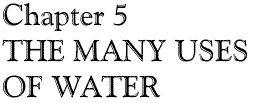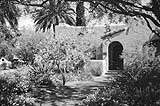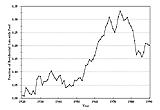|

![[continued]](chap5_05_files/cont.gif)
Faucet use typically accounts for around 15 to 20 percent of indoor
use. Faucet aerators reduce some water use by introducing more air into
the stream, thereby increasing the water’s wetting action. This can save
approximately one gpm over older 3.5 gpm faucets. Other faucet uses, such
as filling a glass or teapot, are unaffected by aerators.
Leaks average approximately 10 percent of indoor water use. Inspection
of the home for leaks as part of a water audit is often an effective way
to save water. Tucson Water offers free leak detection as part of its
Zanjero Program, which provides customers an analysis of the water use in
their home, and information on how to lower their water use and water
bills.
Outdoor Water Use
In the Tucson area, single family residents use 30 to 50 percent of
their water outdoors, for landscape watering, swimming pools, spas,
evaporative cooling and other such uses. Outdoor water use varies over the
year. In the summer before the monsoon rains starts, outdoor water use
peaks as plants require more water to survive and evaporation from pools
is at its greatest. In the winter, outdoor water use drops dramatically,
especially during the winter rainy season from January through March.
Bermuda grass is dormant during this season, and only about seven percent
of landscapes have winter rye grass lawns.
 |
| Figure 5-7 Water is saved when a
landscape consists of desert, drought-tolerant vegitation. Photo:
Barbara Tellman. |
Peak summer water use can be up to twice winter water use. Beat the
Peak, the water conservation campaign created by Tucson Water after the
1975-76 water controversy, was designed to help cut peak consumption.
Water providers must design their distribution systems to meet peak demand
and allow enough reserve supply for fire fighting. If peak demand is
reduced, costs are reduced. A benefit is that lower peak demand has
generally also meant lower total water use.
|
Landscape irrigation is the largest category of outdoor water
demand. Most landscaping in Tucson combines grass with desert
plants. A 1992 random survey of Tucson Water customers found that
about 43 percent of respondents had some grass in their landscaping.
Eight percent of residents reported their landscaping was mostly
grass while the other 35 percent had landscapes combining turf area
with other plant materials.
Since the late 1940s, the percent of new homes with lawns has
generally been declining in Tucson. A 1983 random survey revealed
that about half of the homes built prior to World War II had lawns.
The percentage of homes with lawns declined gradually though the
mid-1970s, and then declined steeply about the time of the 1975-76
water crisis in Tucson. Most evidence indicates that roughly 20
percent of homes built in the late 1980s and early 1990s have
lawns.
Lawns are rarely removed once they are installed. Converting
lawns to desert landscaping, however, became more common in the late
1970s and early 1980s. A sample of Tucson households in 1979 showed
that up to 20 percent of households surveyed had removed their front
lawns, while 15 percent had removed their backyard lawns between
1976 and 1979. This compares to essentially no lawn removal in the
several years before the crisis. Average lawn size also has declined
from a peak of about 2,000 square feet for homes built around 1960
to around 600-800 square feet for homes built since the
mid-1980s.
Relying on a garden hose to water vegetation is the most
prevalent form of irrigation in Tucson. Drip irrigation is the
second most common method of irrigation and has gained significantly
in popularity since the early 1980s. At that time, one percent of
households had drip, compared to approximately 27 percent of
households in the early 1990s. Approximately 22 percent of Tucson
Water service area households reported having in-ground irrigation
systems in the early 1990s. About eight percent of homes surveyed in
the early 1990s did not irrigate their landscaping at all. |
XERISCAPING
Xeriscaping is using efficient landscape design and lower
water use vegetation to create attractive landscapes — and
equally important, to save water. The word “xeriscape”
combines the Greek word “xeros”, meaning dry, with “scape”
from “landscape.” Xeriscaping principles make use of “micro-
climates” that exist in the landscape. Micro-climates are
defined according to the amount of sun and shade, the slope,
and air movement that characterize a landscape.
The property is divided into low, medium and high water use
areas, with the highest water use areas close to the house, in
areas with the most shade. These are cooler areas, and
xeriscaping would limit turf to these areas. Drought-tolerant
plants and native vegetation are used in low water use zones
to provide attractive landscape with a variety of colorful and
interesting plants.
Water harvesting techniques might be applied to capture and
store rainwater for use on plants or to channel runoff
directly to vegetation. Drip irrigation can be installed to
water individual plants, while sprinkler systems are used for
turf. Soil can be improved and topped with mulch to hold water
from rainfall as well as irrigation. Taken together these
practices help residents save both water and money while
creating beautiful and interesting landscapes.
| |
Which irrigation system is most efficient is unclear. Management of the
system is as important as the system hardware. Drip systems and in-ground
turf irrigation systems can be put on timers and programmed to deliver the
right amount of water when needed. But timers need to be reset to adjust
to changing seasons and large rain events. Too often such adjustments are
not made. In such instances, hand watering with a hose could be more
efficient. Deep, infrequent irrigation of mature landscape plants is more
efficient than frequent, shallow irrigation.
 |
| Figure 5-8 Fraction of residential
lots with pool by year home built, Pima County
1920-1990Sources: Pima County, Water Resources Research
Center. |
Swimming pools are less common than lawns in Tucson, but the percentage
of homes with swimming pools has been increasing over time. A swimming
pool typically uses three to five times as much water as the same area of
turf. This is due in part to the fact that most private lawns are
under-irrigated, and pool consumption includes not only evaporation but
also filter back flushing and occasional draining for maintenance.
As is shown in Figure 5-8, the percentage of Tucson homes with pools is
a function of when the home was built, increasing from about 15 percent in
homes built prior to the mid-1950s, to about 22 percent from the mid-1950s
though the 1960s, and then to nearly 30 percent in newer homes. At
present, almost 20 percent of all homes in Pima County have pools.
|



